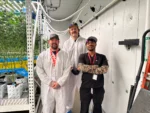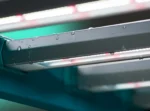Bickel Consulting COO Jeremy Shechter calls his team “the biggest cannabis consulting firm you’ve never heard of.” Find out what makes Bickel’s unique approach to client success the best-kept secret in commercial cultivation.

Since 2015, Bickel Consulting and its small team of growers, engineers, and business-savvy upstarts have become living proof that the best way to stand out in cannabis cultivation is to just do you.
“We only advertise through word of mouth,” said Chief Operating Officer Jeremy Shechter, “and our MO is, no matter what, we always put the client’s needs and interests first.”
What principles guide how Bickel Consulting interacts with clients?
No. 1: Don’t overstay your welcome
When a client approaches Jeremy’s team for help navigating the bureaucracy of growing cannabis, assistance in implementing new technology, or assessing their grow operations for areas of improvement, Bickel is committed to staying flexible, never wanting to outlast their use.
“We don’t ever try to keep people for longer than they absolutely need us,” Jeremy said. “We don’t really do long-term binding contracts. Cannabis is a dynamic industry, and we understand that timelines and details on projects change all the time. We do not want to charge clients if we are not providing value because of macroeconomic shifts, regulatory changes, or other project-specific roadblocks.”
No. 2: Remain objective
As Bickel makes recommendations, which may include tech investment, they base their decisions not on brand loyalty but on specifications relative to what will be best for their clients. They want them working with the best equipment available.
“We never take commissions or kickbacks from the equipment vendors we use.”
No. 3: Foster independence
At the heart of every partnership Jeremy and his team enter into is a doctrine of self-reliance. “Our job is to work ourselves out of a job,” he said. Every project requires a clean exit strategy, but not before teaching their clients how to continue the work themselves.
What does it mean to, like you write on your website, “bridge the gap between the grow room and the boardroom”?
Whether large or small, a true indoor CEA or greenhouse, a good commercial grow has to reconcile the friction between the science and the business—namely, in how these two halves communicate.
“It takes a wide breadth of skills to run cannabis cultivation,” Jeremy said, “and because of the experience my team and I have, we can straddle that pretty well.”
When discussing how to draft SOPs and train the methods, Jeremy hammered home the point that there’s more than one way to grow—longer veg, shorter veg, more pruning, less pruning—and his team has had a lot of success simply meeting people where they are, identifying what they’re trying to accomplish, and connecting the dots.
“We have a general method that’s been proven across dozens of facilities, backed up with improved yield and quality numbers.”
What advice do you have for new cultivators, or cultivators who are looking to shake things up?
Don’t overthink it
While Jeremy has a degree in engineering, he adamantly believes that you don’t need one to be successful in this industry. What matters most is a willingness to learn. If you’re comfortable working with your hands, and you have an eagerness to figure things out and solve problems, you’re already well on your way.
“People are going to look at you and think you’re really smart because the equipment seems so complicated, but once you start using it, it’s really not.”
Consolidate, consolidate, consolidate
Many legacy growers pieced together their disparate control systems as they built their empires—now’s the time to bring it all together. Interfaces for monitoring and controlling the conditions of your grow rooms are critical in making the data-driven decisions behind adjustmenting and optimizing your facility.
“Everything works in harmony,” Jeremy said. “Your light levels are going to impact how your HVAC runs, and your lighting set points need to match up with your CO2 set points, which both need to be graphed relative to your water demand. Being able to compare and analyze everything in one place is, frankly, a lot easier.”
Brush up on Microsoft Excel
Speaking of making things easier, Jeremy recommends that growers never forget that this is a data-driven industry, and to always devote at least a little time to professional development. His biggest tip for anyone aspiring to management positions is to get really good with Excel and understand the numbers within your facility.
“We’ve worked with so many excellent growers who can plant up and down but can’t do very quick production planning or data tracking. They just kind of wing it, and it really hampers them, especially when they move up to the managerial or director level and are expected to report on how their team is doing.”
Highlights from MJBizCon 2024
During last year’s MJBizCon event, Jeremy participated on two session panels, so we’re sharing some key takeaways.
Planning for Success: Navigating Cannabis Cultivation Yields Amid Rapid Market Changes
Jeremy discussed the larger, macroeconomic variables that affect yield, from state and federal regulations to interest rates and declassification, and how to plan for them. He shared with us a story about lettuce farmers who fell into the trap of not understanding their broader markets before betting a lot of money on an indoor farming endeavor that didn’t pan out:
“These big horticultural production facilities plan their projected P&Ls and financial statements around what they can produce, but not necessarily what they can sell. No other business would do that.”
How to Effectively Manage Cultivation Data and Increase Your Yield
Jeremy joined by Maria McIntyre of bioMerieux, Jason Mac Donald of Native Roots Cannabis Co., and Ian Justus of Connected Cannabis Co. to discuss what it really means to be a data-driven cultivator.
“You’ll hear people in cannabis talk about data, data, data, but 90 percent of the time, they’re just talking to talk. When you look behind the curtains, there’s no rigorous data collection.”
To help people better understand industry best practices for data collection and analysis, Jeremy prepares his clients to isolate which specific key performance indicators to target and how to reliably and accurately gather those numbers.
What do your clients think of BIOS lighting?
While we respect Bickel Consulting’s commitment to impartiality, can you blame us for being a little curious? We’ll let Jeremy speak for himself:
“We have a short list of lighting vendors that have done very well for our clients, and BIOS is certainly at the top. Our clients have been happy with the product, the service, the presale support, and documentation, and we see consistent excellent results on both yield and overall quality from the rounds pulled down under BIOS lighting.”



